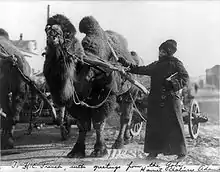Harriet Chalmers Adams
Harriet Chalmers Adams (October 22, 1875 – July 17, 1937) was an American explorer, writer and photographer. She traveled extensively in South America, Asia and the South Pacific in the early 20th century, and published accounts of her journeys in the National Geographic magazine. She lectured frequently on her travels and illustrated her talks with color slides and movies.

Harriet Chalmers Adams | |
|---|---|
 | |
| Born | October 22, 1875 |
| Died | July 17, 1937 (aged 61) |
| Resting place | Chapel of the Chimes |
| Nationality | American |
| Occupation | Explorer, writer, photographer |
| Spouse(s) | Franklin Pierce Adams |
Life and travels
Harriet Chalmers Adams was born in Stockton, California to Alexander Chalmers and Frances Wilkens. On October 5, 1899 she married Franklin Pierce Adams.[1]
In 1900, Adams went on her first major expedition, a three-year trip around South America with her husband, during which they visited every country, and traversed the Andes on horseback.[1] The New York Times wrote that she "reached twenty frontiers previously unknown to white women."[2]
In a later trip she retraced the trail of Christopher Columbus's early discoveries in the Americas, and crossed Haiti on horseback.[3]
War correspondent
Adams served as a correspondent for Harper's Magazine in Europe during World War I. She was the only female journalist permitted to visit the trenches.[3]
When she and her husband visited eastern Bolivia during a second extended trip to South America in 1935, she wrote twenty-one articles for the National Geographic Society that featured her photographs, including "Some Wonderful Sights in the Andean Highlands" (September 1908), "Kaleidoscopic La Paz: City of the Clouds" (February 1909) and "River-Encircled Paraguay" (April 1933). She wrote on Trinidad, Surinam, Bolivia, Peru and the trans-Andean railroad between Buenos Aires and Valparaiso.
In 1925, Adams helped launch the Society of Woman Geographers. In all, Adams is said to have travelled more than a hundred thousand miles, and captivated hundreds of audiences. The New York Times wrote "Harriet Chalmers Adams is America's greatest woman explorer. As a lecturer no one, man or woman, has a more magnetic hold over an audience than she."
She died in Nice, France, on July 17, 1937, at age 61. An obituary in The Washington Post called her a "confidant of savage head hunters" who never stopped wandering the remote corners of the world. She is interred at the Chapel of the Chimes in Oakland, California.[4]
Of women as adventurers, she wrote
I've wondered why men have so absolutely monopolized the field of exploration. Why did women never go to the Arctic, try for one pole or the other, or invade Africa, Thibet, or unknown wildernesses? I’ve never found my sex a hinderment; never faced a difficulty which a woman, as well as a man, could not surmount; never felt a fear of danger; never lacked courage to protect myself. I’ve been in tight places and have seen harrowing things.[5]
Further reading
- Duncan, Joyce (2010). Ahead of Their Time: a Biographical Dictionary of Risk-Taking Women. Portsmouth: Greenwood Publishing Group, Incorporated MyiLibrary [distributor. ISBN 9781280908699. OCLC 1065101531.
References
- Leonard, John William, ed. (1914), Woman's Who's Who of America: A Biographical Dictionary of Contemporary Women of the United States and Canada, 1914-1915, New York: American Commonwealth Company, p. 37.
- "Harriet C. Adams, Explorer, Is Dead". The New York Times. July 18, 1937.
- Our Amazing Planet Staff (April 30, 2012). "8 Unsung Women Explorers". LiveScience.com. Retrieved April 30, 2012.
- Adams at Find A Grave website
- "Woman Explorer's Hazardous Trip In South America", The New York Times, August 18, 2012
General references
- Anema, Durlynn. Harriet Chalmers Adams: Adventurer and Explorer. Aurora, Colorado: National Writers Press, 2004.
External links
| Wikimedia Commons has media related to Harriet Chalmers Adams. |
- Images of Rio, many taken by Harriet Chalmers Adams
- ""The Grand Canyon Bridge", by Harriet Chalmers Adams, from the June 1921 National Geographic Magazine". Archived from the original on October 28, 2009. Retrieved November 12, 2006.
- National Geographic Society– Three Photographs by Harriet Chalmers Adams
- Harriet Chalmers Adams at Find a Grave